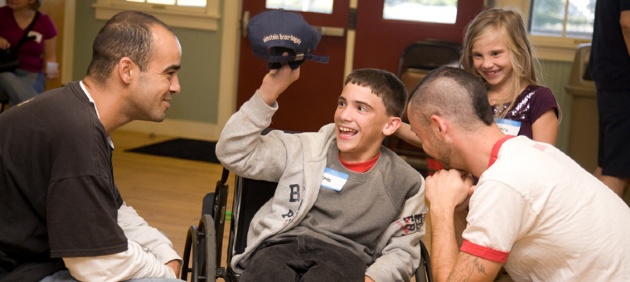The inclusive education approach
recommends that a student with specific challenges and needs shares most of his
or her school time with peers of a similar age and, who, for the most part, are
children without special needs.
The approach of inclusion, however,
involves more than just having the student with special needs evolve within a
regular classroom with or without additional support. The implementation of an
IEP, the involvement of an interdisciplinary team, the participation of an
attendant, the efforts of a technician, the constant communication with parents
and caregivers, and the use of different strategies and new technologies are
integral and must be a part of the multiple efforts used to accommodate a child
with special needs.
Why, then, should we support this approach,
one that was not popular before the 1970’s, but has become the most popular
educational philosophy of the 21st Century? The inclusive education approach
should be applied within all sectors of the system for a variety of reasons.
First, it is our social responsibility to
ensure that all children experience acceptance and respect regardless of their
socio-economic background, ethnicity, or intellectual challenges. This
responsibility extends to every individual in our community. Second, given that
most human behaviours are learned by imitation, there are clear social
advantages for children with special needs to be able to learn from 'regular'
children. Within this scenario, children with special needs are able to learn
to communicate, play, and socialize in more effective ways as they observe and
interact with 'regular' children, who essentially serve as their role models.
Third, inclusive education also has advantages for the child who does
not have special needs. Compassion, acceptance, and respect for children with
limitations are more easily learned through interactions with them. In
addition, ‘regular’ children also become more aware and conscious of the fact
that everyone, to some degree, has differences and limitations.
In
a successful inclusive classroom, the child with special needs is
embraced by teachers and classmates. Although making large changes in the
classroom to accommodate children with special needs may be a daunting task for
both teachers and professionals alike, remarkable success can be attained with
even the smallest of adaptations or modifications. For some children, for
example, reducing noise levels by placing tennis balls at the end of chair legs
can have a tremendous impact on effective learning. In another case, the
adaptation could be as simple as providing proper lighting, or reorganizing
desks within the classroom. Giving the special needs child the opportunity to
learn alongside his/her peers within the optimum environment of an inclusive
classroom can make a tremendous difference in a student’s life.
Contribute
to improving education by sharing the benefits of inclusive education with
others.

 In The Latest Issue:Latest Issue:
In The Latest Issue:Latest Issue:
- Celebrating Community an...
- Celebrating the Unsung H...
- Understanding Newborn St...
Articles
Calendar
Virtual- ANNUAL TEACHER APPRECIATION CONTEST
- APPUI LAVAL
- ARTS & CULTURE
- CAMPS
- CAR GUIDE
- CCIL
- CENTENNIAL ACADEMY
- CHARITY FUNDRAISING
- CITYTV
- COSMODÔME
- COMMUNITY CONNECTIONS
- COVER STORY
- DINA DIMITRATOS
- ÉCOLE SUPÉRIEURE DE BALLET DU QUÉBEC
- EDITORIALS
- ÉDUCALOI
- EDUCATION
- EMPLOYMENT & ENTREPRENEURSHIP
- FÊTE DE LA FAMILLE
- FÊTE DU QUARTIER SAINT-BRUNO
- FAMILIES
- FESTIVAL LAVAL LAUGHS
- FÊTE DE QUARTIER VAL-DES-BRISES
- FINANCES
- GLI CUMBARE
- GROUPE RENO-EXPERT
- HEALTH & WELL-BEING
- 30 MINUTE HIT
- ANXIETY
- CHILDREN`S HEALTH & WELLNESS
- CLOSE AID
- DENTAL WELLNESS
- EXTREME EVOLUTION SPORTS CENTRE
- FONDATION CITÉ DE LA SANTÉ
- GENERAL
- HEARING HEALTH
- MESSAGES FROM THE HEALTH AGENCY OF CANADA
- MENTAL HEALTH
- SEXUALITY
- SOCIAL INTEGRATION
- SPECIAL NEEDS
- TEENS
- THE NUTRITION CORNER
- THE NUTRITION CORNER - RECIPES
- VACATION DESTINATION
- WOMEN'S FITNESS
- WOMEN'S HEALTH
- HILTON MONTREAL/LAVAL
- HOME & GARDEN
- INTERNATIONAL WOMEN'S DAY
- JAGUAR LAVAL
- LAVAL À VÉLO
- LAVAL FAMILIES TV SHOW
- LAVAL FAMILIES MAGAZINE CARES
- LAVAL URBAN IN NATURE
- LE PARCOURS DES HÉROS
- LES PETITS GOURMETS DANS MA COUR
- LEON'S FURNITURE
- LEONARDO DA VINCI CENTRE
- LFM PREMIERES
- LIFE BALANCE
- M.P. PROFILE
- MISS EDGAR'S AND MISS CRAMP'S SCHOOL
- MISSING CHILDREN'S NETWORK
- NETFOLIE
- NORTH STAR ACADEMY LAVAL
- OUTFRONT MEDIA
- PASSION SOCCER
- PARC DE LA RIVIÈRE-DES-MILLE-ÎLES
- PÂTISSERIE ST-MARTIN
- PIZZERIA LÌOLÀ
- PLACE BELL
- PORTRAITS OF YOUR MNA'S
- ROCKET DE LAVAL
- SACRED HEART SCHOOL
- SCOTIA BANK
- SHERATON LAVAL HOTEL
- SOCIÉTÉ ALZHEIMER LAVAL
- STATION 55
- STL
- SUBARU DE LAVAL
- TECHNOLOGY
- TEDXLAVAL
- TODAY`S LAURENTIANS AND LANAUDIÈRE
- TODAY`S LAVAL
- WARNER MUSIC
- THIS ISSUE
- MOST RECENT
Magazine
Why Support the Inclusive Education Approach?
The approach of inclusion involves more than just having the student with special needs evolve within a regular classroom with or without additional support.
Articles ~e 105,7 Rythme FM 4 chemins Annual Teacher Appreciation Contest Appui Laval Arts & Culture Ballet Eddy Toussaint Camps THIS ISSUE MORE...
CONTESTS Enter our contests
CONTESTS Enter our contests
CALENDAR
Events & Activities
COMMUNITY Posts Events
PUBLICATIONS Our Magazine Family Resource Directory
LFM BUSINESS NETWORK Learn more
COUPONS Click to save!
COMMUNITY Posts Events
PUBLICATIONS Our Magazine Family Resource Directory
LFM BUSINESS NETWORK Learn more
COUPONS Click to save!
SUBSCRIPTIONS
Subscribe to the magazine
Un-Subscribe
E-NEWSLETTER Subscribe to our E-newsletter Un-Subscribe
WRITE FOR US Guidelines & Submissions
POLLS Vote today!
E-NEWSLETTER Subscribe to our E-newsletter Un-Subscribe
WRITE FOR US Guidelines & Submissions
POLLS Vote today!
ADVERTISERS
How to & Media guide
Pay your LFM invoice
SUGGESTIONS Reader's Survey Suggest a Listing
LFM About Us Our Mission Giving Back Contact Us
SUGGESTIONS Reader's Survey Suggest a Listing
LFM About Us Our Mission Giving Back Contact Us
 PICK-UP LOCATIONS
Get a copy of LFM!
PICK-UP LOCATIONS
Get a copy of LFM!
TERMS & CONDITIONS Privacy | Terms
ISSN (ONLINE) 2291-1677
ISSN (PRINT) 2291-1677
Website by ZENxDESIGN



 BY:
BY: 


Tweet
Share